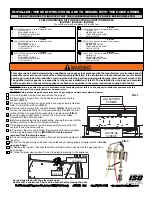
12
Temco PVF7400 Series
78186
M
White
Black
G
Temperature
Sensor
Speed
Control
Switch
120
Volt
Fan
T173
Fig. 12 Blower wiring diagram.
Gas Pressure Check
The gas inlet pressure specified in Table 1 is the
pressure where the field-installed gas line connects to
the gas control. This is measured at the inlet test port
on the gas valve in the appliance. Ensure that pres-
sure is as shown in Table 1.
Table 1
Gas Inlet Pressure
Natural
Propane
Max.
14.0” w.c.
14.0” w.c.
Normal
7.0” w.c.
11.0” w.c.
Min.*
5.0” w.c.
10.8” w.c.
Regulator Pressure
3.5” w.c.
10.0” w.c.
*Minimum inlet supply pressure for the purpose of input adjustment.
The manifold pressure is controlled by the gas valve
and should be checked at the pressure test point
located on the front lower left (inlet side) of the valve.
(Fig. 13)
The pressure should be checked with the appliance
burning on high (highest setting) and all other appli-
ances turned on. One must then read the manometer
and if pressures are not 10.0” w.c. for LP or 3.5” w.c.
for Natural gas the inlet pressure must be adjusted or
increased until the proper pressures are attained. If
these pressures are greater than 10.2” w.c. for LP or
3.7” w.c. for Natural gas, contact your gas supplier
before operating the appliance.
Main Valve ON/OFF/
PILOT Control
HI/LO Flame
Adjustment Control
Blue Flame
(Front Burner)
ON/OFF Control
Manifold Pressure Check
Inlet Pressure
Check
Piezo Pilot
Ignitor
T174
Fig. 13 PVF7400 Series control panel.
After measuring the pressure, replace the test point
plug and check for leaks.
CAUTION: If the appliance's operating pressures
are not checked and adjusted, improper combus-
tion may result in soot being produced. Record
the results of the gas pressure check on the
appropriate documents.
TESTING THE GAS PIPING. Test all piping for leaks.
When checking gas piping to the heater with gas
pressure less than 1/2 psi, shut off manual gas valve
for the heater. If gas piping is to be checked with the
pressure at or above 1/2 psi, the heater and manual
shut off valve must be disconnected during testing to
prevent damage to the regulator on the unit. (SEE
WARNING).
To ensure that the gas lines and connections do not
have any leaks, a pressure test should be performed.
Only a qualified installer should perform the
pressure test to ensure that the unit is not dam-
aged by high pressures!
WARNING: Be sure that the gas type indicated
on the gas log rating plate concurs with the gas
system in your building.
WARNING
DANGER OF PROPERTY DAMAGE,
BODILY INJURY OR DEATH.
Never use a match or open flame to test for
leaks. Never exceed specified pressures for
testing. High pressures may damage the appli-
ance regulator which would require replacement.
Liquid petroleum (L.P.) is heavier than air and it
will settle in any low area, including open de-
pressions and it will remain there unless area is
ventilated.
Never attempt start-up of unit before thoroughly
ventilating area.
If you connect natural gas to an LP gas unit, you
may be unable to ignite the pilot. If the pilot does ignite,
the front burner flame on the low setting will be bright
blue but only 1/4” to 1/2” long and most likely lifting off
the burner ports. If this is the case, turn the unit off
immediately and contact the dealer where the unit
was purchased.
If you connect LP gas to a natural gas unit, the front
burner flame on the low setting will be about 6” - 8”
long. On the medium and high setting, the front burner
flames will be bright yellow and about 10” in length.
Turn the unit off immediately! If the unit is allowed to
run in this condition, substantial amounts of soot will be
generated and emitted into the house. contact the
dealer where the unit was purchased.












































